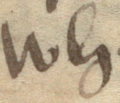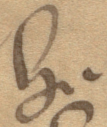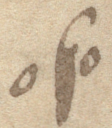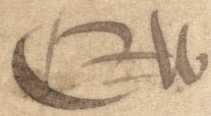|
| A |
 | Usage: argonautis
most of the scribe's lower case 'a's follow the example shown here. There is usually a hairline stroke ascending at an oblique angle from the head of the graph, the extension of the hairline closing stroke. |  | Usage: sal
occasionally the stroke across the head is thicker. |
 | Usage: And
upper case 'A's often look rather tortured and ill-defined. | | Usage: And |
|
| D |
 | Usage: diuers
'd' is looped with a bowl which is either rounded or oval as here. |  | Usage: And
'd' in final position always has an extended tag descending below the graph. |
 | Usage: worde
the first element of 'e' is a continuation of the loop of 'd'. A hairline connects to the second element of 'e'. | | Usage: dayis |
|
| G |
 | Usage: gaf
like the 'a' graph, 'g' has an extended hairline stroke angling up obliquely from the head. |  | Usage: kengis
the tail loops round and crosses the descending stroke to join to the next graph. |
 | Usage: strangast |  | Usage: argonautis |
|
| H |
 | Usage: hatht
'h' has a looped head-stroke which connects back to the stem. The shoulder is set away from the stem and the tail-stroke loops back and crosses itself to connect to the next graph. |  | Usage: Qwhoso |
 | Usage: qwyhlle |  | Usage: The |
|
| R |
 | Usage: resson
'z'-shaped 'r' is used on all occasions in every position. |  | Usage: diuers |
 | Usage: thar |  | Usage: argonautis |
|
| S |
 | Usage: sal
long 's' is used in initial and medial positions. |  | Usage: diuers
an 's' similar to German 'ss' is always used in final position. |
 | Usage: Qwhoso
the stem of 's' is often very thick with a contrasting much finer stroke for the head. |  | Usage: anssowr |
|
| W |
 | Usage: wyn
'w' always has a much extended left arm wherever it occurs. |  | Usage: sowld |
 | Usage: qwht |  | Usage: Qwhoso |
|
| Y |
 | Usage: qwhylle
'y' and thorn are exactly the same and difficult to distinguish. |  | Usage: wyn |
 | Usage: y(c)h |  | Usage: thay |
|
| Thorn |
 | Usage: þat |  | Usage: þaj |
| | | | |


































